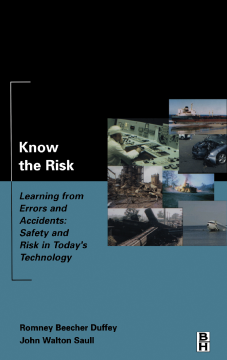
Additional Information
Book Details
Abstract
We live in a technological world, exposed to many risks and errors and the fear of death. Know the Risk shows us how we can learn from the many errors and tragic accidents which have plagued our developing technological world.
This breakthrough volume presents a new concept and theory that shows how errors can and should be analyzed so that learning and experience are accounted for. The authors show that, by using a universal learning curve, errors can be tracked and managed so that they are reduced to the smallest number possible.
The authors have devoted a number of years to gathering data, analyzing theories relating to error reduction, design improvement, management of errors and assignment of cause. The analyzed data relates to millions of errors. They find a common thread between all technology-related accidents and link all of these errors (from the headline stories to the everyday accidents). They challenge the reader to take a different look at the stream of threats, risks, dangers, statistics and errors by presenting a new perspective.
The book makes use of detailed illustrations and explores many headline accidents which highlight human weaknesses in harnessing and exploiting the technology we have developed; from the Titanic to Chernobyl, Bhopal to Concorde, the Mary Rose to the Paddington rail crash and examine errors over which we have little or no control. By analyzing the vast data society has collected, the authors show how the famous accidents and our everyday risks are related.
The authors prove the strength of their observations by comparing their findings to the recorded history of tragedies, disasters, accidents and incidents in chemical, airline, shipping, rail, automobile, nuclear, medical, industrial and manufacturing technologies. They also address the management of Quality and losses in production, the search for zero defects and the avoidance of personal risk and danger.
Stresses the importance of a learning environment for safety improvement
Places both quality and safety management in the same learning context
Learn how to track and manage errors to reduce as quickly as possible
'One of the most daunting features about major accidents is the complexity of their surface details. For years now, accident theorists have been struggling to find a common underlying pattern that will promote more effective risk management.
Now, I believe, one has been found. In their excellent book, Romney Duffey and John Saull have advanced a thesis that is both extraordinarily elegant in its simplicity and extremely persuasive in the light of the wide range of evidence that they adduce to support it. Learning to reduce errors, they argue, is proportional to the number of errors being made. Clearly, then effective error management depends upon tracking the progress in error reduction down the universal learning curve. This, of course, depends critically on a database that tracks errors and defects in an accurate and timely manner. There is much discussion among safety specialists about how to achieve a learning culture--a culture that profits from its accumulated experience. This book provides very clear directions.
In my view, it should be required reading for all those concerned with the management of risks, both human and technical, in hazardous operations.'
[James Reason, Head of Psychology Department at
Manchester University, UK, 2002]
'This is a very useful book and the diligent reader with be well rewarded for the new insights it contains.'
Safety & Health Practitioner - May 2003
